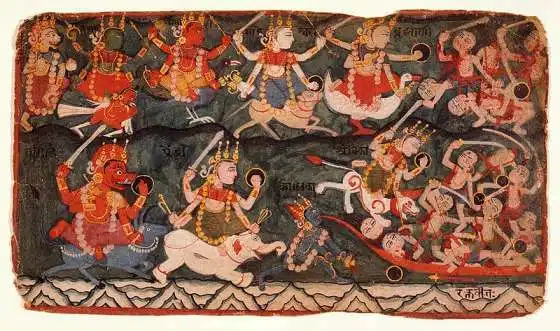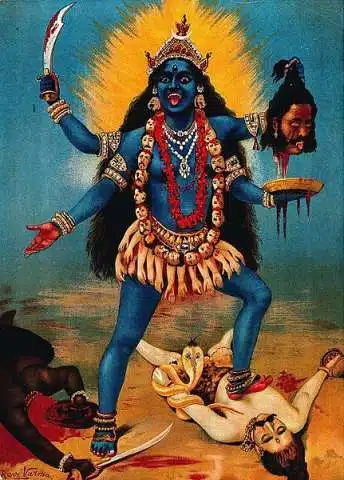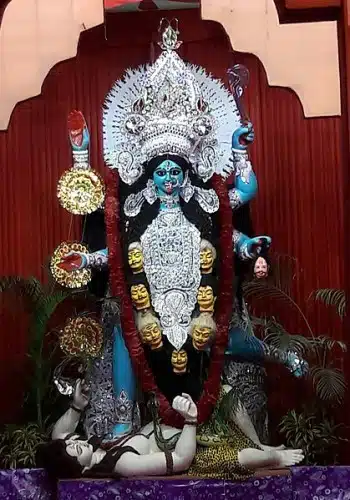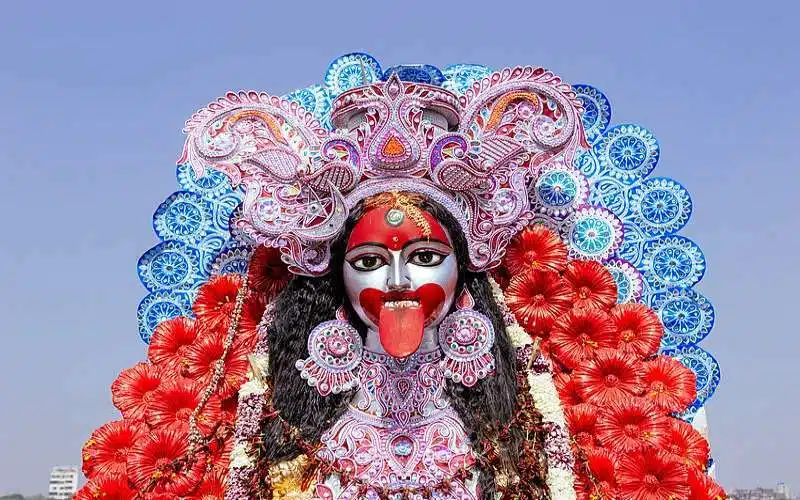All the Goddesses in Hinduism are the divine manifestation of feminine energy. This feminine energy has multiple nodes of expression – from the beautiful, elegant, graceful, creative, generous, motherly to the courageous, warrior, and angry destroyer of all evils, Goddesses in Hinduism are manifestations of multiple qualities and characteristics. Goddess Kali or Ma Kali is the fierce manifestation of Maa Durga.
The story of Goddess Kali and her origins are best narrated in the 13 chapters of the Devi Mahatmyam, also known as Chandi Paat and Durga Saptashati ( 700 verses to Goddess Durga) in the Markandeya Purana.
Maa Kali is considered the Goddess of death and destruction. But this shouldn’t be taken at a literal level. Kali symbolizes the death of ego, of the inherent selfish worldview of human beings and with the destruction of the material ego, she paves the way for Moksha or liberation of the soul.
Goddess Kali can be seen killing many demons in stories of Hindu mythology. It’s also a symbolic representation of the overcoming of the demons of the soul that devotees can overcome by worshipping Maa Kali.
She is not specifically associated with the process of human death like the Hindu God Yama(who is literally the God of Death in Hinduism). According to Hindu myths, Goddess kali is believed to inhabit cremation grounds just like lord Shiva and some devotees go to such places to worship the Goddess. But it’s not symbolic of the celebration of death. Rather, it’s an acknowledgment of the temporary condition of the mortal body and thus paving the way for the death of the illusory ego.
Origin of Goddess Kali Name
The name Kali comes from the Sanskrit word Kaal that means time.
As the embodiment of time, she represents a full circle of life. She is the feminine form of Kala (time), which is a form of Lord Shiva. Goddess Kali is the manifestation of the eternal march of time. There is nothing that escapes the gaze of time. With time, life takes a full circle paving way for destruction that will lead to the cycle of creation again.

Time is seemingly ruthless but beneath all the facade, it;s benevolent. Similarly, Maa Kali has a scary outer facade but beneath that facade, she is a benevolent mother of the Universe guiding her children towards Moksha or Salvation.
Goddess Kali is is classified as a Nirguna.Therefore, she has no permanent qualities, and she will continue to exist even when the universe ends.
Essence of Goddess Kali
Maa Kaali is the most compassionate of all forms of Hindu Goddess or Devi because she paves the way for the liberation of the soul.
Maa kaali is the female counterpart of lord Shiva who is considered the Goddess of Destruction in Hinduism. Just as Shiva had taken in all the poison that emerged during the Samudra Manthan (churning of the divine seas) in his throat and thus he got the name Neelkanth( one with a blue throat), Goddess Kali destroys the illusory ego of all her devotees. That’s why Maa Kali will appear in a fearsome form to people who are over attached to their egos. But if your worship her with utmost devotion without the barrier of the ego, you will see her as an affectionate, sweet and compassionate mother overflowing with eternal love for her children.
In that sense, Maa Kali also symbolizes eternal and boundless love.
Goddess Kali Origins
According to one legend, Goddess Kali was born from the sleeping body of Lord Vishnu. Vishnu was supposed to protect Lord Brahma and the world from the two demons Madhu and Kaitabha. She appeared as the goddess Yoga Nidra to wake him up. Once Vishnu woke up, he waged war against both of them. After a long battle, two demons were still undefeated. Finally, Yoga Nidra took the form of Mahamaya to enchant and distract the two demons. They were enchanted by the beauty of Mahamaya. In that time of their weakness, Vishnu killed them.
In one story, the mortal and immortal worlds were terrorized by the demon Daruka. But according to a boon given to him, he could only be killed by a woman. As a result, the Gods requested that goddess Parvati kill the demon. She responded by jumping down Shiva’s throat. The poison present in Shiva’s throat combined with Parvati, and she transformed into Kali. After coming out of Shiva’s throat, she immediately killed Daruka, and peace in the world was restored.
In another story, demons Chanda and Munda attacked Goddess Durga. Goddess Durga responded with such anger that her face turned dark. And Goddess Kali emerged from her forehead. Seeing the chaos, she defeated both demons. According to legend, most of the demons in Chanda Munda’s army died out of fear and shock, seeing Maa Kali’s terrifying and powerful form.
Goddess Kali Representation
Goddess Kali is portrayed as having a dark blue complexion with four hands and a garland of skulls. She is often depicted wearing a skirt of dismembered arms. The garland and the skull signify the trophies collected while fighting evil in her quest to liberate her children from the illusory trappings of the mortal body.

Her eyes are red with intoxication and anger. Her hair is disheveled, and her tongue is red and out. She is holding a sword in one hand and a fresh severed head dripping with blood in another. The iconography of Kali as quite violent and gruesome can be misleading. Without knowing the symbolic significance of this iconography, people might be led to think Hinduism is a religion of death, destruction and cruelty.However, this seemingly violent depiction actually symbolizes the destruction of demons that reside within each of u. Furthermore, it symbolizes the dissolving of the illusory boundaries of the self.
The sword signifies divine knowledge, and the human head symbolizes the human ego. It represents that the human ego must be slain by divine knowledge. Only in this manner can moksha be attained. She is also sometimes shown as the “ten-armed Mahakali.” As Mahakali, she has ten feet, ten heads, and three eyes on each head. These three eyes represent the sun, moon, and fire.
Her dark skin is symbolic of the womb of the quantum unmanifest from which all creation rises and will eventually dissolve into that very womb. She is often depicted as standing on lord Shiva whose white skin and calm and prostrate body is a contrast to her dark skin and aggressive demeanour. Lord Shiva represents pure formless spirit of awareness while the Goddess Kali represents form eternlaly supported by the formless spirit.
Legends of Goddess Kali

The most popular legend has her assisting Goddess Durga in her attempt to kill the demon Mahishasura. Mahishasura was a half-buffalo demon. He got the boon from Lord Brahma that only a woman could kill her. When he began terrorizing the world, the Gods sought the assistance of Goddess Parvati. And from her, Goddess Durga was born. But as the demon was changing forms every time the Goddess came near to kill him. So, she needed help, and Kali was said to be one of the Goddesses who helped her in his defeat.
How Goddess Kali got a red tongue
Another story tells us how her tongue got red. There was an asura named Shumbha who proposed to Goddess Ambika. She challenged him to show that he was stronger than her. To show this, Shumbha dispatched an army, but she and the goddess Kali (a form of Durga) killed the entire army.
Shumbha, now infuriated, concluded that she needed to be humbled. So he himself marched out in front of his large army. He showed a magnificent demonstration of strength. Goddess Ambika gave birth to a new goddess, Chandika, to oppose him and his army. Shumbha retaliated by surrounding Chandika. At this moment, other gods and goddesses came to her rescue.
On seeing this,Shumbha released Rakt-Beej. Rakt-Beej was a boon given to him. According to this, if even a drop of blood from his body fell to the ground, another demon would emerge, fully formed and ready to battle. The clone’s blood also generated more clones. Thus, it made him unstoppable.
Chandika used a variety of weapons, but as blood streamed from his wounds, thousands of clones swarmed the battlefield. Chandika said to Kali that, in order to defeat him, not even a drop of blood should fall on the ground. So, Kali extended her tongue out and raced over the battleground. She captured every drop of blood that fell. Shumbha and his clones, now unable to expand any further, charged towards Chandika but died at her hands.
Kali and the Brahmin monk
One story tells of the encounter between Goddess Kali and some thieves. The thieves wanted to make a human sacrifice to please her. But unfortunately, they chose a Brahmin monk for sacrifice. They took him to the nearest temple and started making preparations for the sacrifice. Finally, when they started to make sacrifices, the statue of Kali came to life. She was angry at the thieves for kidnapping the monk. She took revenge and decapitated all of them. The monk escaped and led his life as a scholar and a devotee of the goddess.
Manifestations
Goddess Kali has different manifestations. They are more like different aspects of her nature.
Mahakali means “Great Kali” in Sanskrit.Hence, she is the greater form of Kali. She is associated with empowerment. Mahakali is portrayed with ten heads and represents the ten Mahavidyas (the great wisdom goddesses). She is the feminine form of Mahakala (the great time). Her consort is Lord Bhairava, the god of consciousness.
Dakshina Kali is the most popular form of Kali in Bengal, India. She is a benevolent being who shields people from misfortune. Her two right hands are shown in the gesture of blessing. This is her creative aspect. At the same time, she has her fierce side.Yama (the Lord of Death) is said to have fled in death after hearing her name.So, her worship is said to be able to overcome death itself.
Samhara Kali is the embodiment of the power of destruction. She is the most dangerous and powerful form of Kali. She brings about death, and thus liberation. Her depiction as standing on a corpse and holding a freshly cut head. She is mainly worshiped by warriors and tantrics.
Bhadra Kali is considered an auspicious and fortunate form of Mahakali. She protects the good. According to legend, she killed many demons. So, she is the symbol of fortitude as well as fierceness.
Raksha Kali is a local form of Kali, which is said to protect against epidemics and other natural disasters.
Devotion

Goddess Kali is considered by her devotees to be the Mother of all living beings just as Goddess Saraswati by her worshipers. Kali protects the innocent against oppression and injustice. She is also seen as a provider of moksha. She is worshiped as the ultimate reality.
Her worship is done not only to appease her but also to avoid her wrath. Historically, worshipers have done animal sacrifice to please Goddess Kali, although this practice is not followed all over India and it is one the wane now. In many temples, Maa Kali is worshipped without any animal sacrifice. Also, red millet is offered to her as her favorite food.
The Goddess is worshiped in homes in the form of idols made of clay and also at night with tantric rites and mantras. She is said to release all karmic bondage, ignorance, and darkness. She helps her devotees realize the power of their inner selves. As worshipers of goddess Ganga clean their deeds by bathing in the holy river. Similarly, by worshiping Goddess Kali, her devotees clean their negative aura and thoughts. Maa Kali is said to empower her worshipers by helping them face their fears. They become able to liberate themselves from unhealthy attachments and egoistic thoughts.
Kali Puja during Diwali
Some people also do Kali puja at night during the festival of Diwali. Some people also do Kali pooja by persnifying the pen and the inkpot as Goddess Kali. A Swastika symbol is drawn on to these with red sandalwood paste. Once Swastika has been drawn on the pen and the inkpot, Kali Puja begins.
Kali Pooja is more prevalent in the eastern states of India, especially west Bengal. It is typically done on Diwali night where the pooja begins at around 9;30 pm and goes on till late at night. Once the pooja ceremony is completed, Bengali bhog prasad(offerings to God) is distributed to devotees. This bhog includes khichdi(a sattvik dish made of rice) and various kinds of sweet delicacies.
Maa Kali and Ramakrishna Paramhans
Ramakrishna Paramhans, a great Hindu saint was a devotee of Maa Kali.
He was the priest of Dakshineswar temple, situated along the banks of river Ganga.
The devotion of Ramakrishna Paramhans to Goddess kali knew no bounds, He would erupt into fits of ecstasy and go berserk to have a mere glimpse of Maa Kali. the great saint would go without food for days thinking that Maa Kali would come herself and feed him.
Ramakrishna Paramhans’s life is that of unparalleled and unconditional devotion to Maa Kali.
According to Legend, Maa Kali herself appeared in front of Ramakrishna Paramhansa rewarding him for his selfless devotion.
Symbols of Kali
Colors
Blue or Black are the colors asscoiated with Goddess Kali. These signify the sky and the ocean. These colors also represent her as a transcendent power of time.
Red color is also often attributed to her. Devotees offer saris of red color during puja.
Plants
Hibiscus: The hibiscus plant is associated with Goddess Kali. Through this plant, she is the manifestation of primordial energy. The petals have the unique ability to emit divine consciousness.
Flowers of crimson glory, dark roses, and Aboli are also offered to Maa Kaali.
Perfumes/Scents
Jasmine: The jasmine scent associated with Goddess Kali brings pure light and joy. It is said to attract physical and spiritual love. It brings all kinds of abundance and heightens spiritual awareness.
Nag Champa – The Nag Champa scent is often associated with Goddess Kali. It has a strong and sweet smell that brings feelings of calm and introspection. Nag Champa scent is made from a mixture of floral and herbal essential oils, and it thus symbolizes the feminine divine energy of Goddess Kali.
Gems and Metals
Black Tourmaline: This stone shields from negative energy just as Goddess Kali does. It is considered to be highly protective against negative thoughts, too.
Smoky Quartz: This stone is said to complete the circuit between nature and human beings. They help send negative energy back to earth and recycle it for good.
Garnet: It is associated with Goddess Kali as it helps to feel safe and secure, and brings a sense of calm.
Labradorite: It also clears the aura and is said to be a magic stone in this sense.
Planet
Planet Rahu is associated with Goddess Kali.
FAQs about Kali
Kali is the goddess of destruction, liberation, and compassion.
Lord Shiva is the consort of Goddess Kali, who is the manifestation of goddess Parvati.
Kali is the manifestation of Goddess Parvati. .
The name of Goddess Kali is derived from the Sanskrit word “Kaala” which means time. She is the feminine counterpart of time.
Other Goddesses
If you enjoyed this post we are sure you will enjoy getting to know some of the other goddesses we also write about. You can find the complete list of goddesses sorted across regions and religions here.
Featured Image Credit: Subhrajyoti07, CC BY-SA 4.0, via Wikimedia Commons


